HC1031 Report: Analyzing Management Theories in Organizations
VerifiedAdded on 2023/03/30
|8
|1316
|82
Report
AI Summary
This report delves into the evolution of management theories, focusing on bureaucratic and human relations approaches. It examines the core principles, strengths, and limitations of bureaucratic management, highlighting its emphasis on hierarchy, rules, and efficiency, using Microsoft as an example. The report then explores McGregor's X and Y theory, comparing authoritarian and participative leadership styles and analyzing their impact on employee motivation and organizational performance, with Haier Group as a case study. The analysis provides a comprehensive understanding of how different management theories shape organizational structures, leadership styles, and employee behavior. The report concludes with a discussion on the application of these theories in contemporary organizations, emphasizing the importance of adapting leadership styles to meet organizational needs. The report provides detailed analysis and references to support the findings.
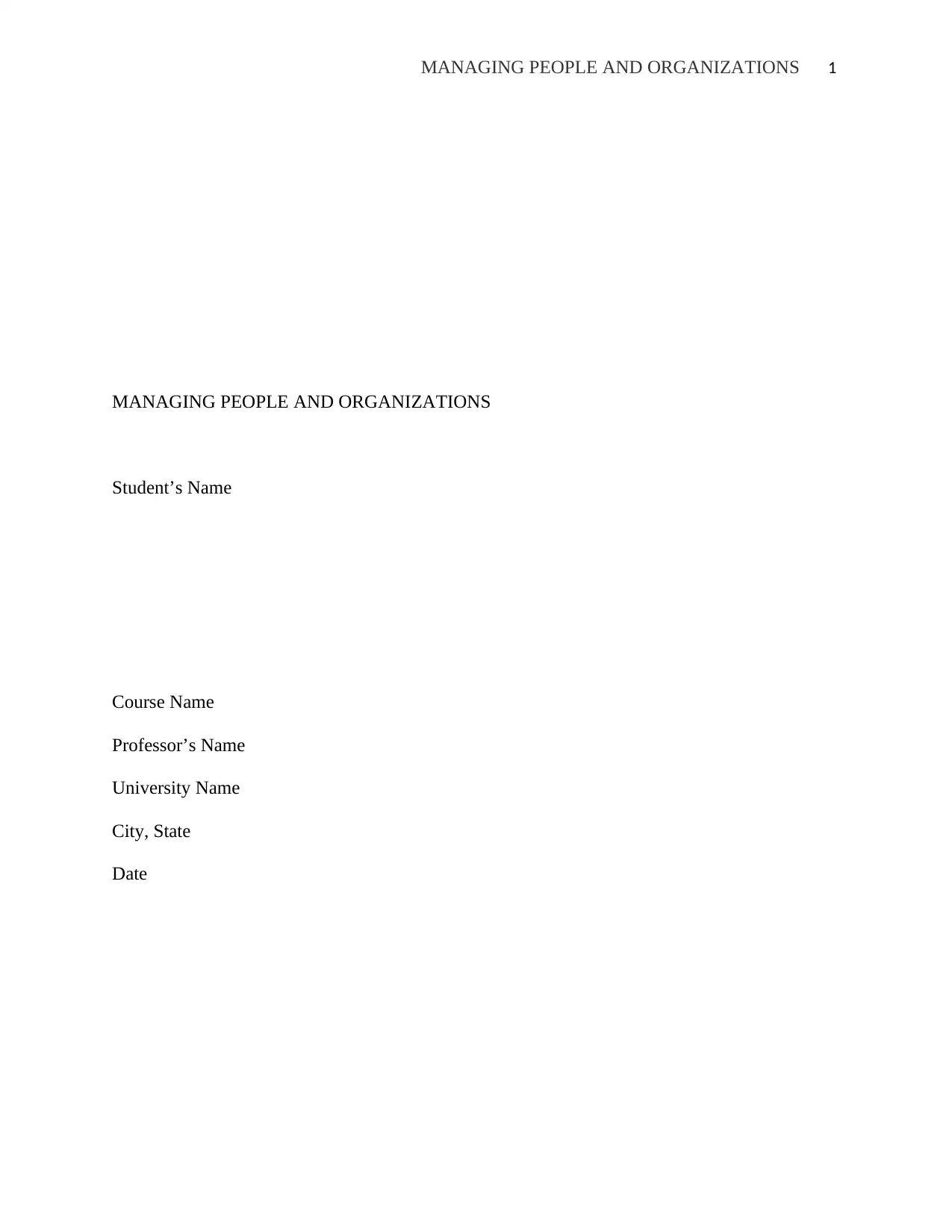
MANAGING PEOPLE AND ORGANIZATIONS 1
MANAGING PEOPLE AND ORGANIZATIONS
Student’s Name
Course Name
Professor’s Name
University Name
City, State
Date
MANAGING PEOPLE AND ORGANIZATIONS
Student’s Name
Course Name
Professor’s Name
University Name
City, State
Date
Paraphrase This Document
Need a fresh take? Get an instant paraphrase of this document with our AI Paraphraser
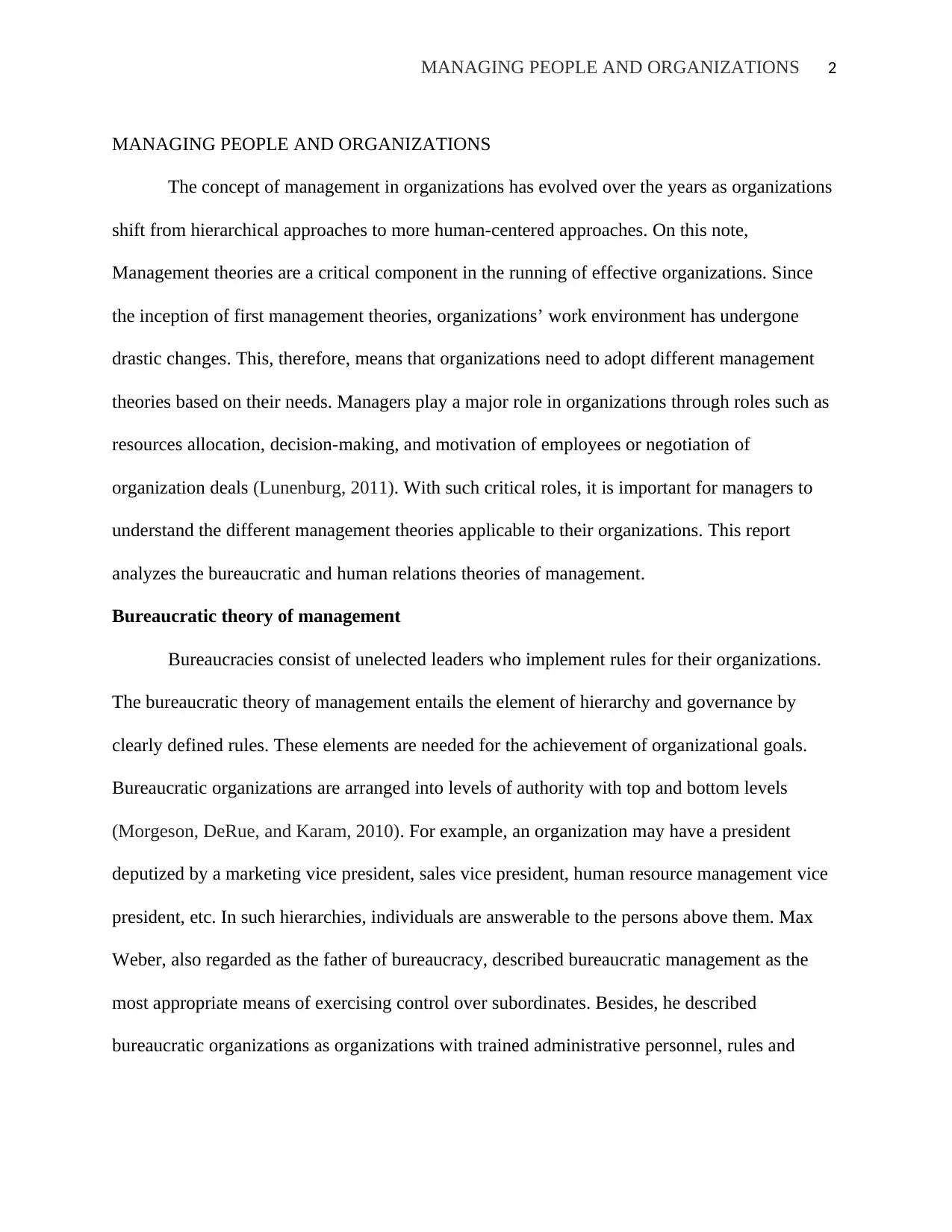
MANAGING PEOPLE AND ORGANIZATIONS 2
MANAGING PEOPLE AND ORGANIZATIONS
The concept of management in organizations has evolved over the years as organizations
shift from hierarchical approaches to more human-centered approaches. On this note,
Management theories are a critical component in the running of effective organizations. Since
the inception of first management theories, organizations’ work environment has undergone
drastic changes. This, therefore, means that organizations need to adopt different management
theories based on their needs. Managers play a major role in organizations through roles such as
resources allocation, decision-making, and motivation of employees or negotiation of
organization deals (Lunenburg, 2011). With such critical roles, it is important for managers to
understand the different management theories applicable to their organizations. This report
analyzes the bureaucratic and human relations theories of management.
Bureaucratic theory of management
Bureaucracies consist of unelected leaders who implement rules for their organizations.
The bureaucratic theory of management entails the element of hierarchy and governance by
clearly defined rules. These elements are needed for the achievement of organizational goals.
Bureaucratic organizations are arranged into levels of authority with top and bottom levels
(Morgeson, DeRue, and Karam, 2010). For example, an organization may have a president
deputized by a marketing vice president, sales vice president, human resource management vice
president, etc. In such hierarchies, individuals are answerable to the persons above them. Max
Weber, also regarded as the father of bureaucracy, described bureaucratic management as the
most appropriate means of exercising control over subordinates. Besides, he described
bureaucratic organizations as organizations with trained administrative personnel, rules and
MANAGING PEOPLE AND ORGANIZATIONS
The concept of management in organizations has evolved over the years as organizations
shift from hierarchical approaches to more human-centered approaches. On this note,
Management theories are a critical component in the running of effective organizations. Since
the inception of first management theories, organizations’ work environment has undergone
drastic changes. This, therefore, means that organizations need to adopt different management
theories based on their needs. Managers play a major role in organizations through roles such as
resources allocation, decision-making, and motivation of employees or negotiation of
organization deals (Lunenburg, 2011). With such critical roles, it is important for managers to
understand the different management theories applicable to their organizations. This report
analyzes the bureaucratic and human relations theories of management.
Bureaucratic theory of management
Bureaucracies consist of unelected leaders who implement rules for their organizations.
The bureaucratic theory of management entails the element of hierarchy and governance by
clearly defined rules. These elements are needed for the achievement of organizational goals.
Bureaucratic organizations are arranged into levels of authority with top and bottom levels
(Morgeson, DeRue, and Karam, 2010). For example, an organization may have a president
deputized by a marketing vice president, sales vice president, human resource management vice
president, etc. In such hierarchies, individuals are answerable to the persons above them. Max
Weber, also regarded as the father of bureaucracy, described bureaucratic management as the
most appropriate means of exercising control over subordinates. Besides, he described
bureaucratic organizations as organizations with trained administrative personnel, rules and
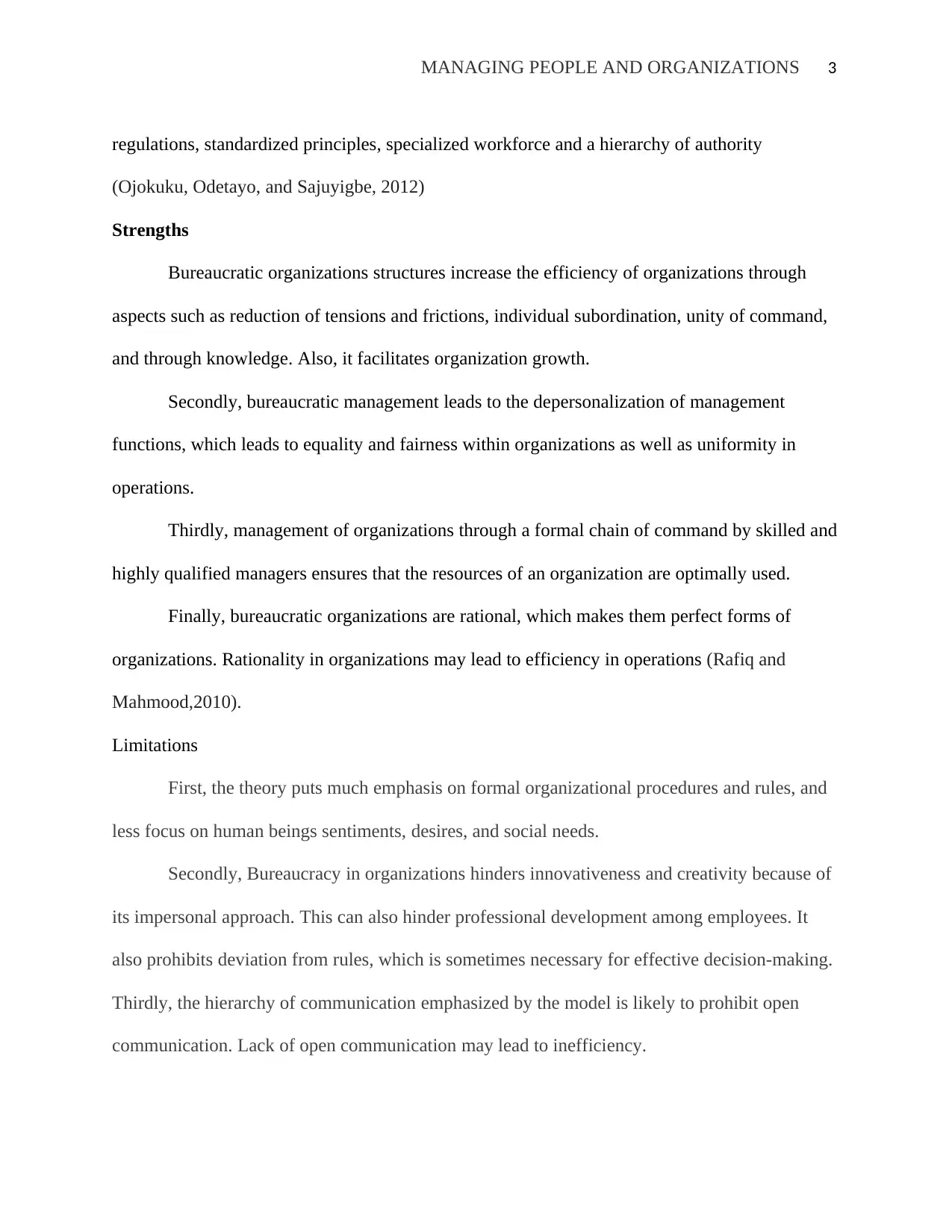
MANAGING PEOPLE AND ORGANIZATIONS 3
regulations, standardized principles, specialized workforce and a hierarchy of authority
(Ojokuku, Odetayo, and Sajuyigbe, 2012)
Strengths
Bureaucratic organizations structures increase the efficiency of organizations through
aspects such as reduction of tensions and frictions, individual subordination, unity of command,
and through knowledge. Also, it facilitates organization growth.
Secondly, bureaucratic management leads to the depersonalization of management
functions, which leads to equality and fairness within organizations as well as uniformity in
operations.
Thirdly, management of organizations through a formal chain of command by skilled and
highly qualified managers ensures that the resources of an organization are optimally used.
Finally, bureaucratic organizations are rational, which makes them perfect forms of
organizations. Rationality in organizations may lead to efficiency in operations (Rafiq and
Mahmood,2010).
Limitations
First, the theory puts much emphasis on formal organizational procedures and rules, and
less focus on human beings sentiments, desires, and social needs.
Secondly, Bureaucracy in organizations hinders innovativeness and creativity because of
its impersonal approach. This can also hinder professional development among employees. It
also prohibits deviation from rules, which is sometimes necessary for effective decision-making.
Thirdly, the hierarchy of communication emphasized by the model is likely to prohibit open
communication. Lack of open communication may lead to inefficiency.
regulations, standardized principles, specialized workforce and a hierarchy of authority
(Ojokuku, Odetayo, and Sajuyigbe, 2012)
Strengths
Bureaucratic organizations structures increase the efficiency of organizations through
aspects such as reduction of tensions and frictions, individual subordination, unity of command,
and through knowledge. Also, it facilitates organization growth.
Secondly, bureaucratic management leads to the depersonalization of management
functions, which leads to equality and fairness within organizations as well as uniformity in
operations.
Thirdly, management of organizations through a formal chain of command by skilled and
highly qualified managers ensures that the resources of an organization are optimally used.
Finally, bureaucratic organizations are rational, which makes them perfect forms of
organizations. Rationality in organizations may lead to efficiency in operations (Rafiq and
Mahmood,2010).
Limitations
First, the theory puts much emphasis on formal organizational procedures and rules, and
less focus on human beings sentiments, desires, and social needs.
Secondly, Bureaucracy in organizations hinders innovativeness and creativity because of
its impersonal approach. This can also hinder professional development among employees. It
also prohibits deviation from rules, which is sometimes necessary for effective decision-making.
Thirdly, the hierarchy of communication emphasized by the model is likely to prohibit open
communication. Lack of open communication may lead to inefficiency.
⊘ This is a preview!⊘
Do you want full access?
Subscribe today to unlock all pages.

Trusted by 1+ million students worldwide
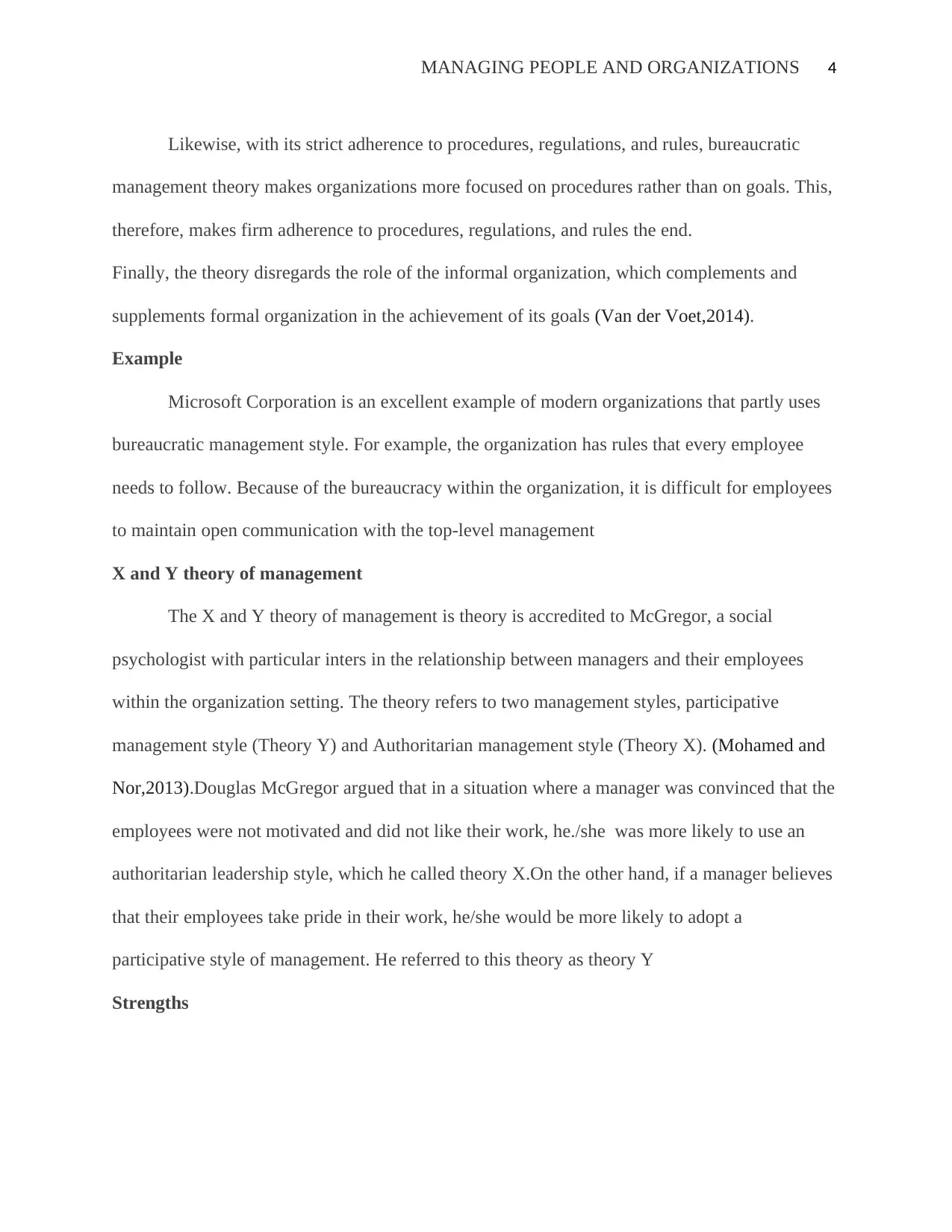
MANAGING PEOPLE AND ORGANIZATIONS 4
Likewise, with its strict adherence to procedures, regulations, and rules, bureaucratic
management theory makes organizations more focused on procedures rather than on goals. This,
therefore, makes firm adherence to procedures, regulations, and rules the end.
Finally, the theory disregards the role of the informal organization, which complements and
supplements formal organization in the achievement of its goals (Van der Voet,2014).
Example
Microsoft Corporation is an excellent example of modern organizations that partly uses
bureaucratic management style. For example, the organization has rules that every employee
needs to follow. Because of the bureaucracy within the organization, it is difficult for employees
to maintain open communication with the top-level management
X and Y theory of management
The X and Y theory of management is theory is accredited to McGregor, a social
psychologist with particular inters in the relationship between managers and their employees
within the organization setting. The theory refers to two management styles, participative
management style (Theory Y) and Authoritarian management style (Theory X). (Mohamed and
Nor,2013).Douglas McGregor argued that in a situation where a manager was convinced that the
employees were not motivated and did not like their work, he./she was more likely to use an
authoritarian leadership style, which he called theory X.On the other hand, if a manager believes
that their employees take pride in their work, he/she would be more likely to adopt a
participative style of management. He referred to this theory as theory Y
Strengths
Likewise, with its strict adherence to procedures, regulations, and rules, bureaucratic
management theory makes organizations more focused on procedures rather than on goals. This,
therefore, makes firm adherence to procedures, regulations, and rules the end.
Finally, the theory disregards the role of the informal organization, which complements and
supplements formal organization in the achievement of its goals (Van der Voet,2014).
Example
Microsoft Corporation is an excellent example of modern organizations that partly uses
bureaucratic management style. For example, the organization has rules that every employee
needs to follow. Because of the bureaucracy within the organization, it is difficult for employees
to maintain open communication with the top-level management
X and Y theory of management
The X and Y theory of management is theory is accredited to McGregor, a social
psychologist with particular inters in the relationship between managers and their employees
within the organization setting. The theory refers to two management styles, participative
management style (Theory Y) and Authoritarian management style (Theory X). (Mohamed and
Nor,2013).Douglas McGregor argued that in a situation where a manager was convinced that the
employees were not motivated and did not like their work, he./she was more likely to use an
authoritarian leadership style, which he called theory X.On the other hand, if a manager believes
that their employees take pride in their work, he/she would be more likely to adopt a
participative style of management. He referred to this theory as theory Y
Strengths
Paraphrase This Document
Need a fresh take? Get an instant paraphrase of this document with our AI Paraphraser
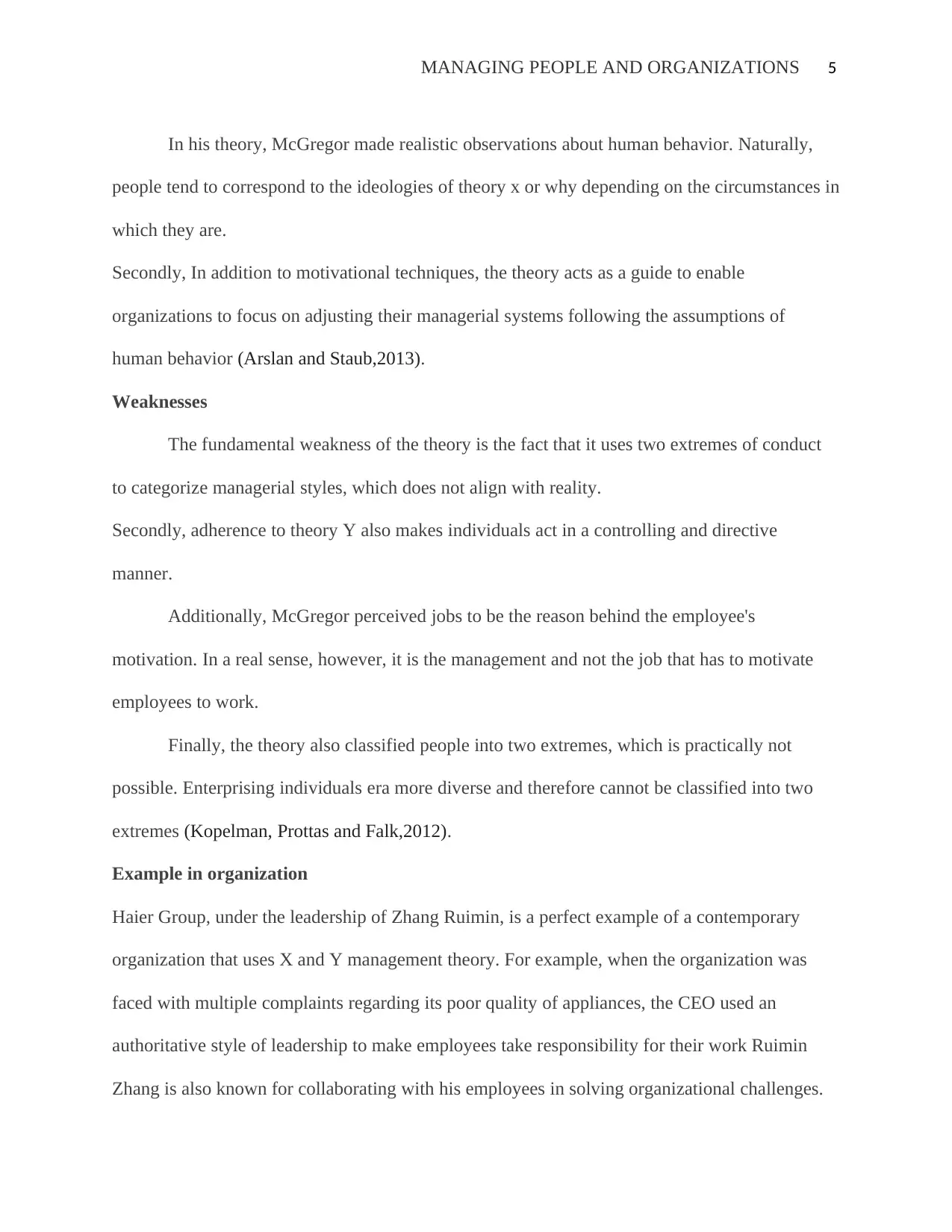
MANAGING PEOPLE AND ORGANIZATIONS 5
In his theory, McGregor made realistic observations about human behavior. Naturally,
people tend to correspond to the ideologies of theory x or why depending on the circumstances in
which they are.
Secondly, In addition to motivational techniques, the theory acts as a guide to enable
organizations to focus on adjusting their managerial systems following the assumptions of
human behavior (Arslan and Staub,2013).
Weaknesses
The fundamental weakness of the theory is the fact that it uses two extremes of conduct
to categorize managerial styles, which does not align with reality.
Secondly, adherence to theory Y also makes individuals act in a controlling and directive
manner.
Additionally, McGregor perceived jobs to be the reason behind the employee's
motivation. In a real sense, however, it is the management and not the job that has to motivate
employees to work.
Finally, the theory also classified people into two extremes, which is practically not
possible. Enterprising individuals era more diverse and therefore cannot be classified into two
extremes (Kopelman, Prottas and Falk,2012).
Example in organization
Haier Group, under the leadership of Zhang Ruimin, is a perfect example of a contemporary
organization that uses X and Y management theory. For example, when the organization was
faced with multiple complaints regarding its poor quality of appliances, the CEO used an
authoritative style of leadership to make employees take responsibility for their work Ruimin
Zhang is also known for collaborating with his employees in solving organizational challenges.
In his theory, McGregor made realistic observations about human behavior. Naturally,
people tend to correspond to the ideologies of theory x or why depending on the circumstances in
which they are.
Secondly, In addition to motivational techniques, the theory acts as a guide to enable
organizations to focus on adjusting their managerial systems following the assumptions of
human behavior (Arslan and Staub,2013).
Weaknesses
The fundamental weakness of the theory is the fact that it uses two extremes of conduct
to categorize managerial styles, which does not align with reality.
Secondly, adherence to theory Y also makes individuals act in a controlling and directive
manner.
Additionally, McGregor perceived jobs to be the reason behind the employee's
motivation. In a real sense, however, it is the management and not the job that has to motivate
employees to work.
Finally, the theory also classified people into two extremes, which is practically not
possible. Enterprising individuals era more diverse and therefore cannot be classified into two
extremes (Kopelman, Prottas and Falk,2012).
Example in organization
Haier Group, under the leadership of Zhang Ruimin, is a perfect example of a contemporary
organization that uses X and Y management theory. For example, when the organization was
faced with multiple complaints regarding its poor quality of appliances, the CEO used an
authoritative style of leadership to make employees take responsibility for their work Ruimin
Zhang is also known for collaborating with his employees in solving organizational challenges.
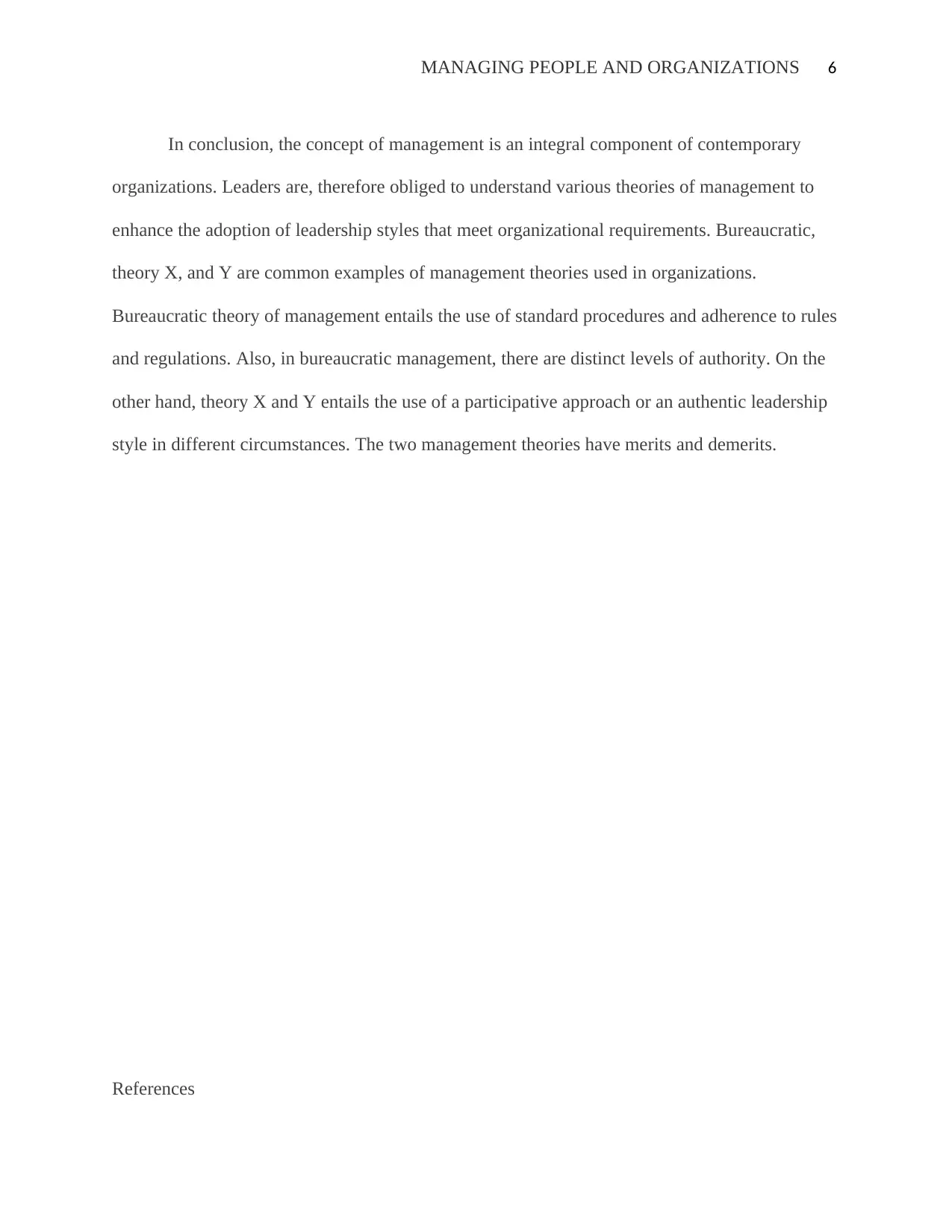
MANAGING PEOPLE AND ORGANIZATIONS 6
In conclusion, the concept of management is an integral component of contemporary
organizations. Leaders are, therefore obliged to understand various theories of management to
enhance the adoption of leadership styles that meet organizational requirements. Bureaucratic,
theory X, and Y are common examples of management theories used in organizations.
Bureaucratic theory of management entails the use of standard procedures and adherence to rules
and regulations. Also, in bureaucratic management, there are distinct levels of authority. On the
other hand, theory X and Y entails the use of a participative approach or an authentic leadership
style in different circumstances. The two management theories have merits and demerits.
References
In conclusion, the concept of management is an integral component of contemporary
organizations. Leaders are, therefore obliged to understand various theories of management to
enhance the adoption of leadership styles that meet organizational requirements. Bureaucratic,
theory X, and Y are common examples of management theories used in organizations.
Bureaucratic theory of management entails the use of standard procedures and adherence to rules
and regulations. Also, in bureaucratic management, there are distinct levels of authority. On the
other hand, theory X and Y entails the use of a participative approach or an authentic leadership
style in different circumstances. The two management theories have merits and demerits.
References
⊘ This is a preview!⊘
Do you want full access?
Subscribe today to unlock all pages.

Trusted by 1+ million students worldwide
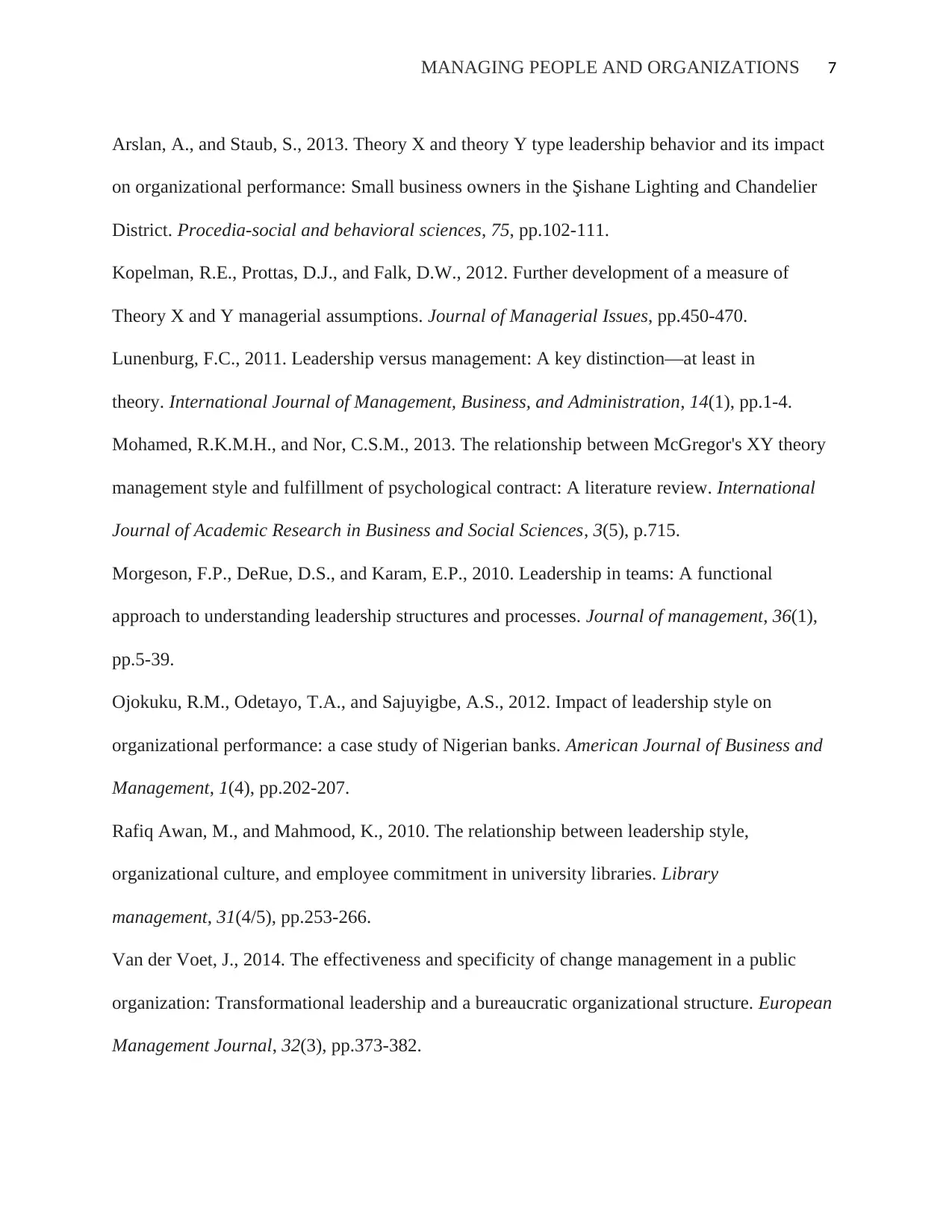
MANAGING PEOPLE AND ORGANIZATIONS 7
Arslan, A., and Staub, S., 2013. Theory X and theory Y type leadership behavior and its impact
on organizational performance: Small business owners in the Şishane Lighting and Chandelier
District. Procedia-social and behavioral sciences, 75, pp.102-111.
Kopelman, R.E., Prottas, D.J., and Falk, D.W., 2012. Further development of a measure of
Theory X and Y managerial assumptions. Journal of Managerial Issues, pp.450-470.
Lunenburg, F.C., 2011. Leadership versus management: A key distinction—at least in
theory. International Journal of Management, Business, and Administration, 14(1), pp.1-4.
Mohamed, R.K.M.H., and Nor, C.S.M., 2013. The relationship between McGregor's XY theory
management style and fulfillment of psychological contract: A literature review. International
Journal of Academic Research in Business and Social Sciences, 3(5), p.715.
Morgeson, F.P., DeRue, D.S., and Karam, E.P., 2010. Leadership in teams: A functional
approach to understanding leadership structures and processes. Journal of management, 36(1),
pp.5-39.
Ojokuku, R.M., Odetayo, T.A., and Sajuyigbe, A.S., 2012. Impact of leadership style on
organizational performance: a case study of Nigerian banks. American Journal of Business and
Management, 1(4), pp.202-207.
Rafiq Awan, M., and Mahmood, K., 2010. The relationship between leadership style,
organizational culture, and employee commitment in university libraries. Library
management, 31(4/5), pp.253-266.
Van der Voet, J., 2014. The effectiveness and specificity of change management in a public
organization: Transformational leadership and a bureaucratic organizational structure. European
Management Journal, 32(3), pp.373-382.
Arslan, A., and Staub, S., 2013. Theory X and theory Y type leadership behavior and its impact
on organizational performance: Small business owners in the Şishane Lighting and Chandelier
District. Procedia-social and behavioral sciences, 75, pp.102-111.
Kopelman, R.E., Prottas, D.J., and Falk, D.W., 2012. Further development of a measure of
Theory X and Y managerial assumptions. Journal of Managerial Issues, pp.450-470.
Lunenburg, F.C., 2011. Leadership versus management: A key distinction—at least in
theory. International Journal of Management, Business, and Administration, 14(1), pp.1-4.
Mohamed, R.K.M.H., and Nor, C.S.M., 2013. The relationship between McGregor's XY theory
management style and fulfillment of psychological contract: A literature review. International
Journal of Academic Research in Business and Social Sciences, 3(5), p.715.
Morgeson, F.P., DeRue, D.S., and Karam, E.P., 2010. Leadership in teams: A functional
approach to understanding leadership structures and processes. Journal of management, 36(1),
pp.5-39.
Ojokuku, R.M., Odetayo, T.A., and Sajuyigbe, A.S., 2012. Impact of leadership style on
organizational performance: a case study of Nigerian banks. American Journal of Business and
Management, 1(4), pp.202-207.
Rafiq Awan, M., and Mahmood, K., 2010. The relationship between leadership style,
organizational culture, and employee commitment in university libraries. Library
management, 31(4/5), pp.253-266.
Van der Voet, J., 2014. The effectiveness and specificity of change management in a public
organization: Transformational leadership and a bureaucratic organizational structure. European
Management Journal, 32(3), pp.373-382.
Paraphrase This Document
Need a fresh take? Get an instant paraphrase of this document with our AI Paraphraser
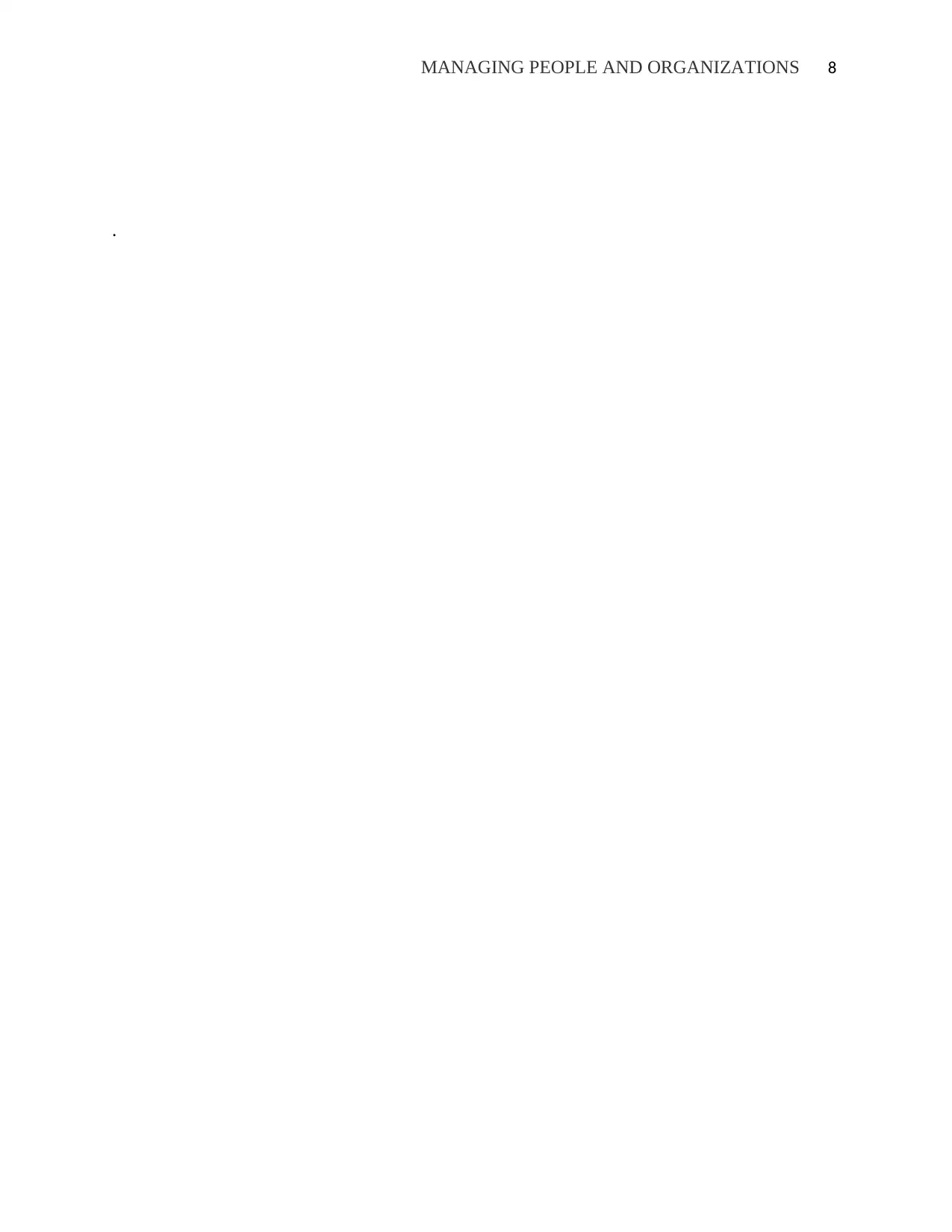
MANAGING PEOPLE AND ORGANIZATIONS 8
.
.
1 out of 8
Related Documents
Your All-in-One AI-Powered Toolkit for Academic Success.
+13062052269
info@desklib.com
Available 24*7 on WhatsApp / Email
![[object Object]](/_next/static/media/star-bottom.7253800d.svg)
Unlock your academic potential
Copyright © 2020–2025 A2Z Services. All Rights Reserved. Developed and managed by ZUCOL.





